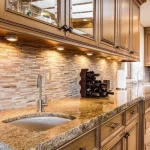
There are several key differences between contemporary and traditional kitchen styles. The traditional look emphasizes natural materials and craftsmanship. Traditional pieces include rich wood, handcrafted tiles, and old-fashioned faucets. Craftsman style kitchens feature a country/farmhouse feel. They also tend to incorporate more natural materials, such as stone and wood, and are characterized by clean lines and solid construction.
This kitchen style is typically found in smaller homes because it maximizes space without sacrificing functionality. Cabinetry lines one wall, creating an open work triangle. This style works well in kitchens where the owners plan to spend a lot of time cooking and entertaining. However, this type of layout may not leave much space for a dining area.
In a traditional kitchen, light fixtures are important to create a warm atmosphere. The type and shape of fixtures used are crucial. The lighting should properly illuminate work surfaces while adding ambience. Traditional kitchens typically have lantern-style lights or shaded wall sconces. The decorative lights create a mood and can also provide task lighting when ambient lighting is not enough.
Another important consideration is color. While choosing a kitchen style, think about the color scheme in other rooms of your home. Some homes use contrasting colors, whereas others have only one or two dominant colors. A modern or traditional kitchen style can blend well with a home that has a bright and neutral color scheme.
Traditional styles are more classic and timeless. They typically incorporate vintage or antique details in their design. Some traditional styles also feature intricate wood cabinetry and ornamental millwork. Contemporary styles, on the other hand, focus on clean lines and sleek materials. Traditional kitchens can also incorporate elements of industrial design. However, if you have a modern kitchen, you can choose between two styles to make a statement.
A traditional kitchen style usually features muted, neutral colors with splashes of brighter colors to add contrast. The colors may include crisp white, ochre, and terracotta. These colors also lend a classic and aesthetically pleasing ambiance. These kitchens are often very warm. You may want to consider incorporating accent colors, such as accent tiles.
Traditional kitchens are often described as “country”. They are characterized by their neutral colour palettes, but you may choose a more eclectic color scheme. Regardless of the style of your kitchen, neutral colours are a good starting point. Traditional kitchens also feature luxurious, natural countertops, and they are optimal for food preparation. A marble slab used for pasties, or a butcher’s block are great examples of traditional countertops. Traditional kitchens may also feature curved countertops or tiered countertops.
Traditional kitchens emphasize craftsmanship and details. Traditional cabinets often have intricate profiles and elaborate molding. The cabinets may be framed or flush-inset. You can even find decorative corbels, and arches adorn the ceiling. This style is also known for its use of antique finishes.









